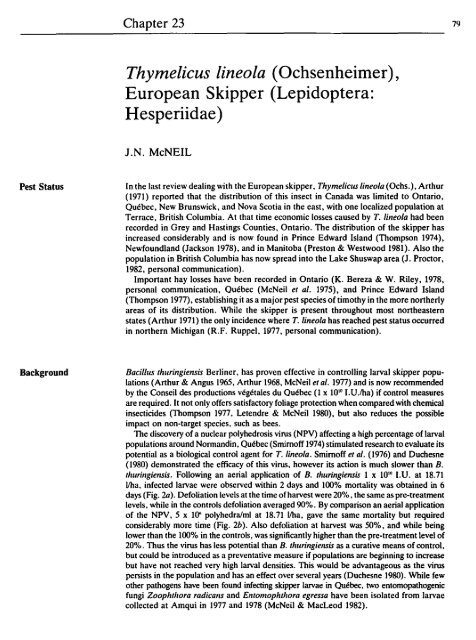pdf, 57.71Mb - Entomological Society of Canada
pdf, 57.71Mb - Entomological Society of Canada
pdf, 57.71Mb - Entomological Society of Canada
You also want an ePaper? Increase the reach of your titles
YUMPU automatically turns print PDFs into web optimized ePapers that Google loves.
Pest Status<br />
Background<br />
Chapter 23<br />
Thymelicus lineola (Ochsenheimer),<br />
European Skipper (Lepidoptera:<br />
Hesperiidae)<br />
J.N. McNEIL<br />
In the last review dealing with the European skipper. Thymelicus lineola (Ochs.), Arthur<br />
(1971) reported that the distribution <strong>of</strong> this insect in <strong>Canada</strong> was limited to Ontario,<br />
Quebec. New Brunswick. and Nova Scotia in the east. with one localized population at<br />
Terrace, British Columbia. At that time economic losses caused by T. Iilleola had been<br />
recorded in Grey and Hastings Counties. Ontario. The distribution <strong>of</strong> the skipper has<br />
increased considerably and is now found in Prince Edward Island (Thompson 1974).<br />
Newfoundland (Jackson 1978). and in Manitoba (Preston & Westwood 1981). Also the<br />
population in British Columbia has now spread into the Lake Shuswap area (J. Proctor.<br />
1982. personal communication).<br />
Important hay losses have been recorded in Ontario (K. Bereza & W. Riley, 1978,<br />
personal communication. Quebec (McNeil et al. 1975), and Prince Edward Island<br />
(Thompson 1977). establishing it as a major pest species <strong>of</strong>timothy in the more northerly<br />
areas <strong>of</strong> its distribution. While the skipper is present throughout most northeastern<br />
states (Arthur 1971) the only incidence where T. lineola has reached pest status occurred<br />
in northern Michigan (R.F. Ruppel, 1977. personal communication).<br />
Bacillus thurillgiellSis Berliner. has proven effective in controlling larval skipper populations<br />
(Arthur & Angus 1965. Arthur 1968. McNeil et al. 1977) and is now recommended<br />
by the Conseil des productions vegetales du Quebec (1 x 10 10 I.U./ha) if control measures<br />
are required. It not only <strong>of</strong>fers satisfactory foliage protection when compared with chemical<br />
insecticides (Thompson 1977. Letendre & McNeil 1980), but also reduces the possible<br />
impact on non-target species, such as bees.<br />
The discovery <strong>of</strong> a nuclear polyhedrosis virus (NPV) affecting a high percentage <strong>of</strong> larval<br />
populations around Normandin. Quebec (Smim<strong>of</strong>f 1974) stimulated research to evaluate its<br />
potential as a biological control agent for T. lineola. Smim<strong>of</strong>f et al. (1976) and Duchesne<br />
(1980) demonstrated the efficacy <strong>of</strong> this virus. however its action is much slower than B.<br />
thurillgiellSis. Following an aerial application <strong>of</strong> B. thllringiellSis 1 x 10 10 I.U. at 18.71<br />
l/ha. infected larvae were observed within 2 days and 100% mortality was obtained in 6<br />
days (Fig. 2a). Defoliation levels at the time <strong>of</strong> harvest were 20%. the same a'i pre-treatment<br />
levels. while in the controls defoliation averaged 90%. By comparison an aerial application<br />
<strong>of</strong> the NPV. 5 x 10 6 polyhedra/ml at 18.71 l/ha. gave the same mortality but required<br />
considerably more time (Fig. 2b). Also defoliation at harvest was 50%, and while being<br />
lower than the 100% in the controls, was significantly higher than the pre-treatment level <strong>of</strong><br />
20%. Thus the virus has less potential than B. thllrillgiensis as a curative means <strong>of</strong> control,<br />
but could be introduced as a preventative measure if populations are beginning to increase<br />
but have not reached very high larval densities. This would be advantageous as the virus<br />
persists in the population and has an effect over several years (Duchesne 1980). While few<br />
other pathogens have been found infecting skipper larvae in Quebec. two entomopathogenic<br />
fungi ZoophtJlOra radicans and Entomophthora egressa have been isolated from larvae<br />
collected at Amqui in 1977 and 1978 (McNeil & MacLeod 1982).<br />
79
















